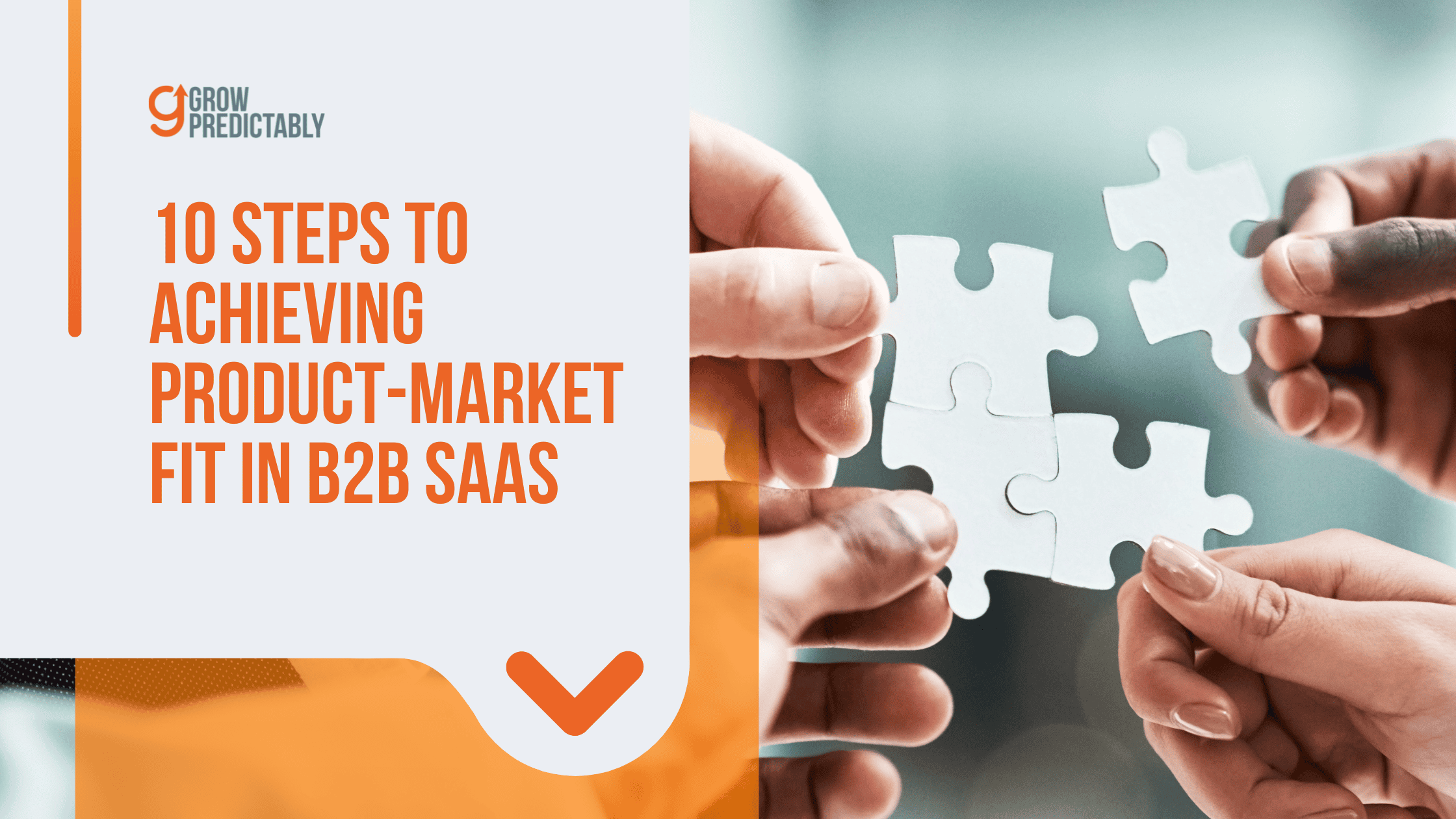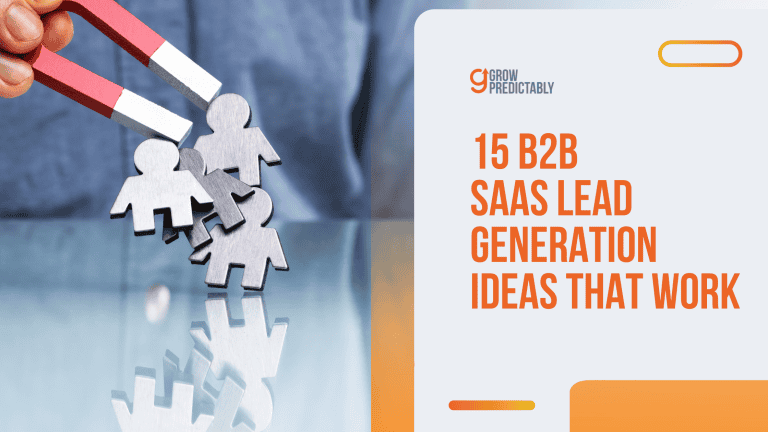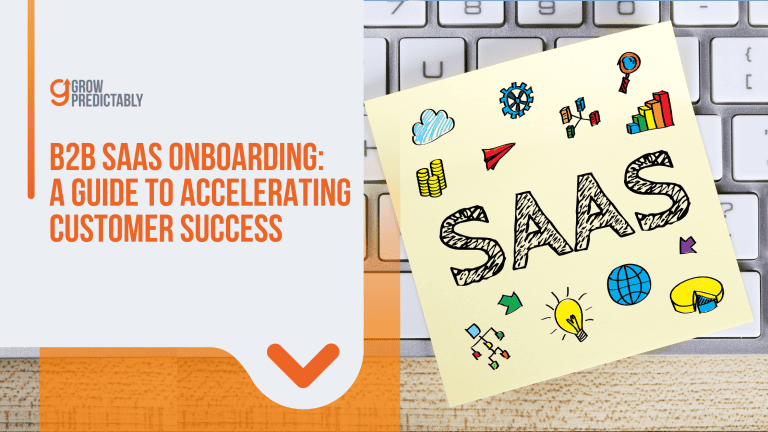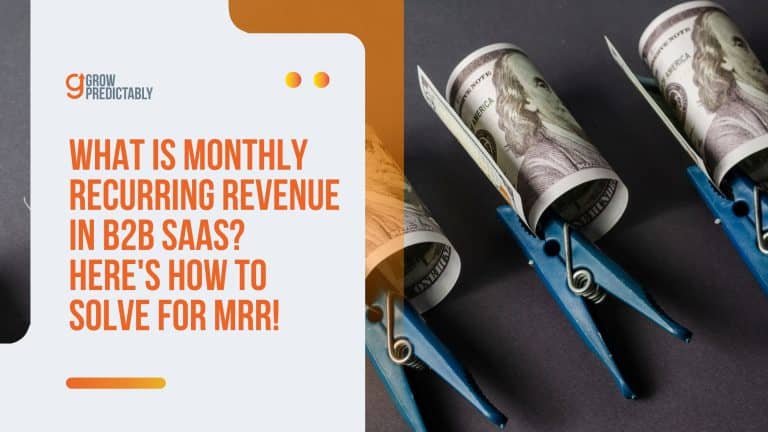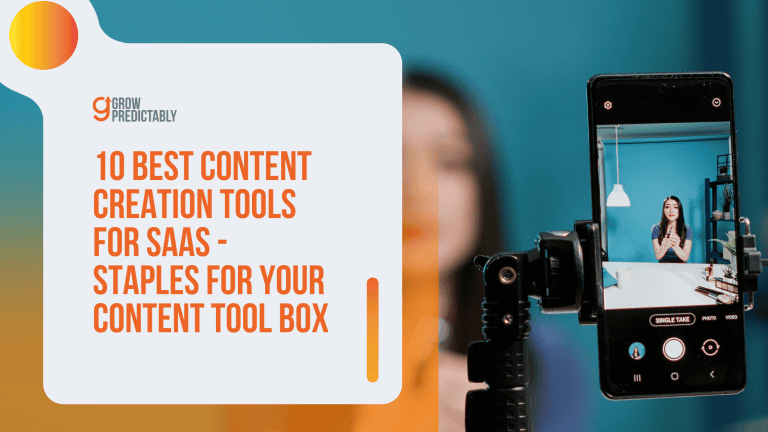10 Steps to Achieving Product-Market Fit in B2B SaaS
Picture this: You build your B2B SaaS product by grinding 100-hour weeks, only to watch it flop.
It happens all the time—42% of startups fail over demand misalignment. (Source)
But when you hit the sweet spot of product-market fit or PMF, the runway for scaling gets way smoother.
What if you knew exactly when your SaaS was truly ready?
We’re about to break down all 10 steps to help you find—or measure—that elusive fit.
Understanding Product-Market Fit in B2B SaaS
Ever wonder why some B2B software companies take off like rockets while others barely leave the ground?
A recent study showed that 42% of startups fail because they build products nobody wants to buy.
That’s where product-market fit comes in.
What is Product-Market Fit?
Product-market fit (PMF) is when your B2B software solves a real problem so well that your target audience or customers can’t imagine going back to their old way of doing things.
It’s like finding the perfect pair of shoes – when you know, you know.
Your customers aren’t just using your product; they’re telling their colleagues about it and getting mad if you try to take it away.
PMF in B2B SaaS
But here’s the thing: PMF in B2B SaaS is different from regular consumer products.
Your software needs to make businesses more money, save them time, or solve a serious headache.
It is not just for one person; it needs to work for entire teams and organizations.
This is why achieving product market fit is crucial to long-term success, primarily through the creation of solutions that resonate across organizational levels.
How to Tell When PMF is Achieved
You’ll know you’ve got PMF when:
- Your customer renewal rates are high.
- People are actively recommending your product.
- Sales cycles get shorter because the word’s getting around.
- Customer support requests shift from “this is broken” to “can we add this feature?”
Many successful companies only truly scale after they’ve achieved product market fit.
The good news?
PMF isn’t some magical accident.
There’s a method to finding it, and we’ll explore exactly how to do that in the next section.
The Ultimate Guide to Achieving Product-Market Fit in B2B SaaS: A 10-Step Framework
As a B2B SaaS founder or product manager, achieving SaaS product-market fit is your north star.
You’ve likely heard Marc Andreessen’s famous quote…
Product-market fit means being in a good market with a product that can satisfy that market.
Marc Andreessen, venture capitalist and co-founder of Andreessen Horowitz
But how do you actually get there?
This guide will walk you through 10 actionable steps to find, achieve, and maintain product-market fit for your B2B SaaS product.
Following this framework will not only help you achieve product market fit but also sustain it long-term.
Step 1: Create Your Customer Avatar Canvas
Understanding your ideal customer isn’t just about basic demographics – it’s about diving deep into their psyche.
The Customer Avatar Canvas helps you document and validate your assumptions about your target audience in a structured way.
The Customer Avatar Canvas is a strategic tool that helps businesses create detailed profiles of their ideal customers.
It goes beyond basic demographics by mapping psychographics, pain points, and the transformation customers experience when using your product.
The canvas includes sections for company details (size, industry, revenue), decision-making patterns, business goals, and current challenges.
This comprehensive understanding helps tailor marketing strategies and product development to meet specific customer needs.
Components of the Customer Avatar Canvas:
This framework comprises several parts that are designed to help you dissect and break down who your real target audience is.

The most crucial parts are as follows:
- Demographic Profile
- Company size and industry
- Annual revenue
- Geographic location
- Technology stack
- Psychographic Elements
- Business goals and objectives
- Decision-making process
- Risk tolerance
- Innovation adoption curve position
- Pain Points Matrix
- Current challenges
- Attempted solutions
- Cost of inaction
- Urgency level
How to Fill Out Your Canvas:
- Start with preliminary market research and assumptions
- Interview potential customers (aim for at least 10)
- Document patterns and commonalities
- Validate findings with your team
- Update regularly as you learn more
In a 2023 survey, 86% of senior marketing executives listed demographics as the most important type of data used for customer profiling. (Source)
Your Customer Avatar Canvas champions this and more by ensuring you truly understand your target customer before building solutions.
Step 2: Identify Your Value Metric
Every successful B2B SaaS product has a clear value metric that shows your target audience and customers exactly what they’re paying for.
This metric does more than just set prices – it shapes your entire product strategy and helps prove your worth to customers.
OpenView Partners reports that companies with clearly defined value metrics have 40% higher revenue growth rates on average.
This makes sense: when paying customers clearly understand your value proposition, they’re more likely to stay and expand their usage.
Identifying a compelling value metric is a cornerstone of achieving product market fit.
Finding Your Value Metric
First, dig deep into these key questions:
- Core Value Assessment
- What major problem does your product solve?
- Which business outcomes improve when customers use your product?
- How do customers currently measure success in this area?
- Customer Success Alignment
- How do customers justify the cost of your product internally?
- What metrics do they report to their leadership?
- Which results make them look good to their bosses?
Validation Checklist
Your value metric must meet these criteria:
- Scalability
- Grows naturally as customers benefit more from your value proposition
- Aligns with your customers’ growth
- Makes sense at different pricing tiers
- Clarity
- Easy to explain in one sentence
- Immediately understood by decision-makers
- Simple to track and measure
- Predictability
- Directly tied to customer success
- Forecasts customer satisfaction
- Indicates potential churn risks
Implementation Guide
- Metric Selection Process
- Survey your most successful customers
- Analyze usage patterns of long-term clients
- Test different metrics with new customers
- Get feedback from your sales team
- Common Pitfalls to Avoid
- Choosing metrics that are too complex
- Picking metrics you can’t accurately measure
- Selecting metrics that don’t scale with customer success
- Monitoring and Adjustment
- Track correlation with customer satisfaction
- Monitor impact on expansion revenue
- Adjust based on customer feedback and usage patterns
A strong value metric helps product managers and founders make better decisions about feature development, pricing strategies, and success programs for your customer base.
It’s worth spending time to get this right – it will impact every aspect of your business’s organic growth.
Step 3: Build a Minimum Lovable Product (MLP)
Going beyond the basic most viable product concept, an minimum lovable product focuses on creating a product that the target audience will genuinely love, not just tolerate.
For B2B products, this means delivering core features that solve critical business problems exceptionally well.
But what even is a minimum lovable product?
A minimum lovable product (MLP) is a product’s initial version that’s designed to delight your target market from the start.
It’s the simplest version of a product that can create an emotional connection with users and make them fall in love with it.
The goal of an MLP is to create a lovable experience, not just a functional one.
An MLP is a critical step in achieving product market fit by fostering customer loyalty early on.
According to ProfitWell, B2B companies that focus on building MLPs see a higher customer retention rate compared to those launching with basic minimum viable products. (Source)

Key Components of Your MLP:
- Core Problem Solution
- One primary use case solved extremely well
- Clear, measurable outcome
- Streamlined user experience
- Documentation Framework
- Quick-start guide
- API documentation (if applicable)
- Use case examples
- Video tutorials
- Success Metrics Dashboard: Track these from day one:
- Time to first value
- Feature adoption rate
- Customer feedback scores
- User engagement patterns
Step 4: Implement the Problem-Solution Fit Framework
For B2B SaaS companies, having a great product isn’t enough – it needs to solve a real problem that your customer base will pay to fix.
Many founders skip proper validation and jump straight to building features. This framework helps you avoid that costly mistake.
The Validation Process
- Problem Discovery Phase
- Schedule in-depth interviews with potential customers
- Focus on understanding their current workarounds
- Document the cost of their existing solutions
- Leverage market research to ensure your solution is positioned effectively against competitors
- Identify which problems they’re actively trying to solve
- Gauge their willingness to pay for a solution
- Use Case Mapping
- Create detailed user stories for each pain point
- Prioritize problems based on frequency and impact
- Document the desired outcomes for each use case
- Map current solutions and their limitations
- Identify gaps in existing SaaS market solutions
- Solution Design and Testing
- Build small, testable prototypes
- Create a beta testing program structure:
- Select diverse beta users across company sizes
- Set clear testing objectives and timelines
- Design feedback collection methods
- Plan iteration cycles based on feedback
- Track implementation challenges
- Monitor user engagement patterns
Red Flags to Watch For
- Low Engagement Signs
- Users not returning after initial trial
- Low feature adoption rates
- High support ticket volume
- Frequent feature confusion
- Long time-to-value metrics
- Market Fit Issues
- Price sensitivity concerns
- Feature requests outside core value proposition
- Low willingness to participate in beta
- Unclear buyer persona patterns
- Difficulty in reaching decision-makers
Remember, product managers and founders often rush through this phase, eager to start building.
But taking time here saves months of development on features nobody wants.
Step 5: Establish Your Sales-Ready Product
Getting your product sales-ready means ensuring it can be effectively sold and implemented without requiring constant developer intervention.
This means customers can buy and start using your product without technical roadblocks getting in the way.
Achieved product market fit makes this process significantly smoother, as customers already recognize your value proposition.
The numbers back this up – 83% of B2B buyers want to handle purchases digitally. (Gartner)
If your product isn’t sales-ready with things like self-service options and clear documentation, you’re missing out on what most of your buyers prefer.
A sales-ready product also makes it easier to scale your business. You have all the essential pieces in place:
- A solid infrastructure that handles new customers smoothly
- Sales materials that help convince potential buyers
- Clear guides that help your customer base implement your product successfully
Think of it this way – even if you have a great product, it won’t sell well if you haven’t built the foundation to support its sale and implementation.
Sales readiness turns a good product into one that’s actually ready for market success.
Sales Readiness Checklist:
- Product Infrastructure
- Scalable onboarding process
- Self-service capabilities
- Integration documentation
- Security compliance
- Sales Enablement Assets Create these essential materials:
- Product demos
- Case studies
- ROI calculator
- Competitive analysis
- Feature comparison sheets
- Implementation Guide Document your:
- Setup process
- Configuration options
- Integration steps
- Troubleshooting procedures
Step 6: Develop Your Product Analytics Framework
B2B SaaS products generate massive amounts of usage data, but without proper analysis, it’s just noise.
A robust analytics framework turns this data into product decisions that drive organic growth.
Analytics also guide your efforts to achieve product market fit by identifying gaps in customer satisfaction.
According to Mixpanel’s Product Benchmarks Report, B2B SaaS companies that regularly track and act on product analytics see a 22% higher user retention rate in their first year.

Additionally, OpenView Partners found that companies with strong product analytics frameworks reduce their customer acquisition costs by up to 30%.
Core Analytics Setup:
- User Journey Tracking
- Map activation points and time-to-value metrics
- Document the complete user onboarding flow
- Identify where users get stuck or drop off
- Track feature discovery sequences
- Measure the time between key actions
- Custom Event Tracking Define and monitor critical events:
- First value moment (e.g., first successful integration)
- Core feature adoption milestones
- Team collaboration patterns
- Integration success rates
- User engagement depth scores
- Error occurrence and resolution times
- Success Metrics Dashboard Create views for:
- Daily/weekly active users with engagement scores
- Feature usage heat maps by user segment
- User flow visualizations with drop-off analysis
- Cohort analysis based on adoption patterns
- Team collaboration metrics
- Customer health scores
Implementation Guide:
- Data Collection Strategy
- Define key metrics aligned with business goals
- Set up proper event-tracking architecture
- Implement user identification systems
- Create data validation processes
- Analysis Framework
- Weekly key metrics review process
- Monthly trend analysis sessions
- Quarterly strategic reviews
- Annual comprehensive analysis
Step 7: Implement a Voice of Customer (VoC) Program
A structured VoC program helps you maintain alignment with customer needs as you scale.
This systematic approach to gathering feedback ensures you’re building features that truly matter to your target market.
Because actively listening to your customers is essential if you want to achieve product-market fit and retain it as you scale.

VoC Framework Components:
- Feedback Collection Channels
- Regular customer interviews
- In-app surveys
- Feature request portal
- Support ticket analysis
- Usage pattern monitoring
- Feedback Processing System: Create a standardized way to:
- Score feedback priority
- Map feedback to product roadmap
- Track implementation status
- Close the feedback loop
- Customer Success Integration Your CS team should:
- Document common user challenges
- Track feature adoption barriers
- Monitor customer health scores
- Identify expansion opportunities
Step 8: Create Your Market Fit Score System
Measuring B2B SaaS product-market fit isn’t guesswork.
A reliable market fit scoring system ensures your product aligns perfectly with the evolving needs of your target audience.
Your scoring system should quantify how well your product meets the needs of your target market through multiple indicators.
Market Fit Indicators:
- Usage Metrics
- Active user growth rate
- Feature adoption depth
- Time-to-value speed
- User retention curves
- Business Metrics Monitor these monthly:
- Customer acquisition cost
- Expansion revenue
- Net revenue retention
- Logo retention rate
Let’s sample a SaaS market fit scoring system for a hypothetical B2B product called TeamTracker – a project management tool designed for remote engineering teams.
TeamTracker’s Market Fit Scoring System:
Core Usage Metrics (40 points total)
- Active Usage Score (15 points)
- 90%+ of seats active weekly = 15 points
- 70-89% active weekly = 10 points
- 50-69% active weekly = 5 points
- Below 50% = 0 points
- Feature Adoption Depth (15 points)
- Teams using 7+ core features = 15 points
- Teams using 5-6 core features = 10 points
- Teams using 3-4 core features = 5 points
- Teams using less than 3 = 0 points
- Time-to-Value Score (10 points)
- Team completes first project within 7 days = 10 points
- Within 14 days = 7 points
- Within 30 days = 3 points
- Beyond 30 days = 0 points
Financial Health Metrics (30 points total)
- Net Revenue Retention (15 points)
- Above 120% = 15 points
- 100-120% = 10 points
- 85-99% = 5 points
- Below 85% = 0 points
- Customer Acquisition Metrics (15 points)
- CAC payback under 6 months = 15 points
- 6-12 months = 10 points
- 12-18 months = 5 points
- Over 18 months = 0 points
Customer Satisfaction Metrics (30 points total)
- NPS Score (10 points)
- Above 50 = 10 points
- 30-50 = 7 points
- 0-29 = 3 points
- Negative = 0 points
- Feature Request Implementation (10 points)
- 80%+ of features built from customer feedback = 10 points
- 60-79% = 7 points
- 40-59% = 3 points
- Below 40% = 0 points
- Support Ticket Resolution (10 points)
- 90%+ resolved within SLA = 10 points
- 80-89% = 7 points
- 70-79% = 3 points
- Below 70% = 0 points
Scoring Interpretation:
- 90-100: Strong SaaS product-market fit
- 70-89: Good fit with room for improvement
- 50-69: Weak fit, needs significant work
- Below 50: Poor fit, requires immediate attention
TeamTracker’s product team reviews this score monthly and takes action when any category drops below 70% of its possible points.
Step 9: Build a Customer Expansion Framework
Your existing customers give off clear signals when they’re ready to expand. The key is knowing what to look for and when to act.
These signals often become more pronounced once you’ve achieved product market fit, as customers naturally explore deeper engagement.
Start by monitoring usage patterns – are teams using your product more frequently or exploring advanced features?
This often indicates they’re getting value and might be ready for more.
Watch for organizational changes, too. When companies hire new team members or restructure departments, they often need additional capabilities.
Monitor support tickets closely – repeated questions about certain features or integration requests can signal unmet needs that you could fill with premium offerings.
Creating Your Expansion Playbook
A good expansion playbook removes the guesswork from the growth process. For feature upsells, document specific triggers that indicate readiness.
For example, if a customer regularly hits usage limits or frequently requests access to locked features, that’s your cue to start a conversation about upgrading.
Think about user seat expansion strategically. When you notice multiple people sharing one login or see increased activity from different IP addresses, reach out with solutions that make team collaboration easier.
Create email templates and conversation guides that focus on the value of proper access and team efficiency.
Implementing the Framework
- Set up regular health checks for your accounts:
- Weekly usage report reviews
- Monthly feature adoption assessments
- Quarterly business review preparations
- Integration usage tracking
- Develop clear actions for different expansion signals:
- Light-touch responses for early indicators
- Direct outreach for strong signals
- Emergency protocols for at-risk accounts
- Success story collection process
The Expansion Conversation
The way you approach expansion conversations matters deeply.
Instead of pushing for immediate upgrades, start with value-focused discussions:
- Review current usage patterns together
- Share relevant success stories from similar customers
- Discuss future plans and potential bottlenecks
- Offer solutions that align with their growth
Building Long-term Growth
Remember that expansion isn’t just about immediate revenue.
It’s about becoming an integral part of your customer’s growth story. Create resources that help customers succeed:
- Growth planning templates
- ROI calculators
- Implementation guides
- Training materials for new team members
Keep tracking post-expansion success carefully.
Did the additional features or seats deliver the promised value? Document these outcomes – they become powerful stories for future expansion conversations.
Step 10: Establish Your Product-Market Fit Maintenance System
Your SaaS market is constantly moving. Competitors release new features, technology creates new possibilities, and customer expectations keep rising.
A MUST: Create a systematic approach to tracking these changes by setting up regular market review sessions with your team.
Pay special attention to how your customers’ businesses are evolving. Are they facing new challenges? Have their priorities shifted?
Sometimes, the problem you initially solved becomes less important while new pain points emerge.
These shifts demand a continuous reassessment of your market fit to stay competitive.
Building Your Maintenance Framework
- Monthly Health Checks Review key indicators of market alignment:
- Feature usage trends
- Customer feedback patterns
- Support ticket themes
- Sales team input on market demands
- Quarterly Deep Dives Schedule thorough reviews of:
- Competitor positioning changes
- Industry trend analysis
- Technology advancement impacts
- Customer success metrics
Customer Advisory Program
Create a structured way to gather deep insights from your most engaged customers.
Your advisory board should include a mix of company sizes and industries.
These conversations often reveal emerging needs before they become widespread demands. Don’t just focus on product feedback.
Use these sessions to understand:
- Changes in their industry
- New challenges they’re facing
- Their plans for the next 1-2 years
- How they measure success
FAQs
Key Takeaways
The companies that nail these trends aren’t just guessing what their market wants – they know.
And that’s making the difference between products that stick and ones that fade away.
In our wrap-up, I’ll show you how to put all these pieces together into a practical game plan.
But first, let’s get real about something: this tech is only as good as the strategy behind it.
Keeping product-market fit isn’t a one-and-done thing.
It’s like maintaining a garden – you gotta keep at it, or things get messy fast.
The steps we covered (tracking usage patterns, staying close to customers, and adjusting your product) need to become part of your regular routine.
Quick Recap of What Matters Most
- Watch those numbers like a hawk (churn rates, NPS scores).
- Keep talking to customers – seriously, schedule those calls.
- Move fast when markets shift.
- Test new features before going all-in.
- Build a team that cares about customer success.
Next Steps
So what’s your next move?
Start by picking one metric that’ll tell you if you’re still on target with your market.
Maybe it’s customer satisfaction scores, maybe it’s feature usage – whatever makes sense for your product.

